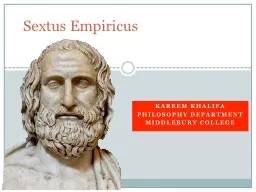

Philosophy Department Middlebury College Sextus Empiricus Overview Background The Five Modes 1 Background 11 Belief and appearances 12 Standards of skepticism 13 Aim of skepticism ID: 566133
Download Presentation The PPT/PDF document "Kareem Khalifa" is the property of its rightful owner. Permission is granted to download and print the materials on this web site for personal, non-commercial use only, and to display it on your personal computer provided you do not modify the materials and that you retain all copyright notices contained in the materials. By downloading content from our website, you accept the terms of this agreement.
Slide1
Kareem KhalifaPhilosophy DepartmentMiddlebury College
Sextus EmpiricusSlide2
OverviewBackgroundThe Five ModesSlide3
1. Background1.1. Belief and appearances
1.2. Standards of skepticism1.3. Aim of skepticismSlide4
2. The Five Modes2.1. Dispute
2.2. Relativity
2.3.
Agrippa’s
TrilemmaSlide5
2.1. DisputeD1.
Equally good arguments for and against p exist.
D2.
If
equally good
arguments
for and against
p
exist,
then we should
suspend judgment about
p
.D3. We should suspend judgment about p. Slide6
2.2.
Relativity
2.2.1
.
‘Perspectival’ Arguments
2.2.2
.
‘Objective’
ArgumentsSlide7
2.2.1
. ‘Perspectival’ Arguments
P1.
The
only way to ascertain which appearances are the objectively correct ones is by appeal to other appearances.
P2
.
Subjects
who differ anatomically, perceptually, environmentally, or culturally will not experience the same appearances.
P3.
There
are subjects who differ anatomically, perceptually,
environmentally, or culturally.
P4
.
There is no way to ascertain which appearances are the objectively correct ones
.Slide8
2.2.2.
‘Objective’ Arguments
P1.
The
only way to ascertain which appearances are the objectively correct ones is by appeal to other appearances.
O1.
Objects
appear differently according to their admixtures, composition, quantity, frequency, and position.
O2
.
???
P4
.
There is no way to ascertain which appearances are the objectively correct ones. (S1, O1, O2?)Slide9
2.3. Agrippa’s Trilemma2.3.1
. No Free Lunch2.3.2.
The Set-Up
2.3.3
.
The ArgumentSlide10
2.3.1.
If q is S’s
justification for believing that
p
, then
S
must be justified in believing that
q.Slide11
2.3.2. Setting up the TrilemmaSuppose that you claim to know that
pHow do you know that p?If q is your justification, then you should answer, “Because
q
”
However, because there are no free lunches, we must be able to answer the question, “How do you that
q
?”Slide12
2.3.2. The Three HornsThis line of questioning has only three possible outcomes:
An infinite regress: I know that p because of q, I know that q because of r…A vicious circle: I know that p because of q, I know that q because of p
An arbitrary stopping point
: I know that p because of q, and I know that q just because.
But we don’t possess infinite reasons, and neither viciously circular reasoning nor arbitrary stopping points seem to provide justification.
Hence we aren’t justified in believing in anything!!Slide13
2.3.3
. The Argument
A1
.
For
all
S, p,
and
q,
if
q
is
S’s
justification for believing that
p
, then
S
must be justified in believing that
q.
A2
.
If
A1 is true, then all justification results in an infinite regress, a vicious circle, or stopping at an arbitrary assumption.
A3
.
We
cannot possess an infinite chain of justification.
A4
.
Viciously
circular reasoning does not provide justification.
A5
.
Stopping
at an arbitrary assumption does not provide
justification.
A6.
No belief is justified. (A1-A5)